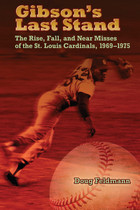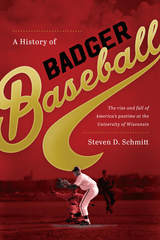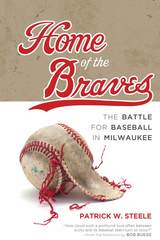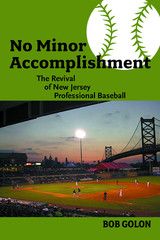4 books about Baseball teams

Gibson's Last Stand
The Rise, Fall, and Near Misses of the St. Louis Cardinals, 1969-1975
Doug Feldmann
University of Missouri Press, 2013
During star-pitcher Bob Gibson’s most brilliant season, the turbulent summer of 1968, he started thirty-four games and pitched every inning in twenty-eight of them, shutting out the opponents in almost half of those complete games. After their record-breaking season, Gibson and his teammates were stunned to lose the 1968 World Series to the Detroit Tigers. For the next six years, as Bob Gibson struggled to maintain his pitching excellence at the end of his career, changes in American culture ultimately changed the St. Louis Cardinals and the business and pastime of baseball itself.
Set against the backdrop of American history and popular culture, from the protests of the Vietnam War to the breakup of the Beatles, the story of the Cardinals takes on new meaning as another aspect of the changes happening at that time. In the late 1960s, exorbitant salaries and free agency was threatening to change America’s game forever and negatively impact the smaller-market teams in Major League Baseball. As the Cardinals’ owner August A. Busch Jr. and manager Albert “Red” Schoendienst attempted to reinvent the team, restore its cohesiveness, and bring new blood in to propel the team back to contention for the pennant, Gibson remained the one constant on the team.
In looking back on his career, Gibson mourned the end of the Golden Era of baseball and believed that the changes in the game would be partially blamed on him, as his pitching success caused team owners to believe that cash-paying customers only wanted base hits and home runs. Yet, he contended, the shrinking of the strike zone, the lowering of the mound, and the softening of the traditional rancor between the hitter and pitcher forever changed the role of the pitcher in the game and created a more politically correct version of the sport.
Throughout Gibson’s Last Stand, Doug Feldmann captivates readers with the action of the game, both on and off the field, and interjects interesting and detailed tidbits on players’ backgrounds that often tie them to famous players of the past, current stars, and well-known contemporary places. Feldmann also entwines the teams history with Missouri history: President Truman and the funeral procession for President Eisenhower through St. Louis; Missouri sports legends Dizzy Dean, Mark McGwire, and Stan “the Man” Musial; and legendary announcers Harry Caray and Jack Buck. Additionally, a helpful appendix provides National League East standings from 1969 to 1975.
Bob Gibson remains one of the most unique, complex, and beloved players in Cardinals history. In this story of one of the least examined parts of his career—his final years on the team—Feldmann takes readers into the heart of his complexity and the changes that swirled around him.
[more]

A History of Badger Baseball
The Rise and Fall of America's Pastime at the University of Wisconsin
Steven D. Schmitt
University of Wisconsin Press, 2017
For more than a century, the University of Wisconsin fielded baseball teams. This comprehensive history combines colorful stories from the archives, interviews with former players and coaches, a wealth of historic photographs, and the statistics beloved by fans of the game. The earliest intercollegiate varsity sport at Wisconsin, the baseball team was founded in 1870, less than a decade after the start of the Civil War. It dominated its first league, made an unprecedented trip to Japan in 1909, survived Wisconsin's chilly spring weather, two world wars, and perennial budget crises, producing some of the finest players in Big Ten history—and more than a few major leaguers. Fan traditions included torchlight parades, kazoos, and the student band playing "A Hot Time in the Old Town Tonight" as early as 1901.
There is painful history here, too. African Americans played on Wisconsin's first Big Ten championship team in 1902, including team captain Julian Ware, but there were none on the team between 1904 and 1960. Heartbreaking to many fans was the 1991 decision to discontinue baseball as a varsity sport at the university. Today, Wisconsin is the only member of the Big Ten conference without a men's baseball team.
Appendixes provide details of team records and coaches, All Big Ten and All American selections, Badgers in the major leagues, and Badgers in the amateur free-agent draft.
There is painful history here, too. African Americans played on Wisconsin's first Big Ten championship team in 1902, including team captain Julian Ware, but there were none on the team between 1904 and 1960. Heartbreaking to many fans was the 1991 decision to discontinue baseball as a varsity sport at the university. Today, Wisconsin is the only member of the Big Ten conference without a men's baseball team.
Appendixes provide details of team records and coaches, All Big Ten and All American selections, Badgers in the major leagues, and Badgers in the amateur free-agent draft.
[more]

Home of the Braves
The Battle for Baseball in Milwaukee
Patrick W. Steele
University of Wisconsin Press, 2020
Winner of the Gambrinus Prize from the Milwaukee County Historical Society
In March 1953, the Boston Braves relocated to Milwaukee. They soon found success with stars like Hank Aaron and Eddie Mathews. The team began drawing bigger crowds than almost any other and went on to win two pennants and a World Series within five years. To fans, it was the dawn of a new dynasty—making it even more of a shock when the owners announced in October 1964 that the Braves would move once again, this time to Atlanta. Patrick Steele examines all facets of the story to understand why the "Milwaukee Miracle" went south.
In March 1953, the Boston Braves relocated to Milwaukee. They soon found success with stars like Hank Aaron and Eddie Mathews. The team began drawing bigger crowds than almost any other and went on to win two pennants and a World Series within five years. To fans, it was the dawn of a new dynasty—making it even more of a shock when the owners announced in October 1964 that the Braves would move once again, this time to Atlanta. Patrick Steele examines all facets of the story to understand why the "Milwaukee Miracle" went south.
[more]

No Minor Accomplishment
The Revival of New Jersey Professional Baseball
Golon, Bob
Rutgers University Press, 2008
America's pastime has roots in New Jersey dating back to 1846 when the first baseball game using modern rules was played on Elysian Fields in Hoboken. The sport thrived throughout the state until the 1950s when fans began to turn away from local competition, preferring to watch games broadcast on television, to take a trip to see a major league team in New York, or to frequent newly air-conditioned movie theaters or bowling alleys. By the early 1990s, however, a growing disenchantment with the high ticket prices and corporate atmosphere of Major League Baseball led to the revival of a purer form of the sport in the Garden State.
In No Minor Accomplishment, sports historian and New Jersey native Bob Golon tells the story of the state's baseball scene since the Trenton Thunder arrived in 1994. Drawing on interviews with team owners and employees, industry executives and fans, Golon goes behind the scenes to show how maintaining a minor league ball club can be a risky business venture. Stadiums cost millions to build, and a team full of talented players does not immediately guarantee success. Instead, each of the eight minor league and independent professional teams in the state must tailor themselves to the communities in which they are situated. Shrewd marketing is necessary to attract fans, but Golon also explains how, unlike Major League Baseball, the business aspect of the minor and independent leagues is not something the average spectator notices. For the fans, baseball in New Jersey is wholesome, exciting family entertainment.
In No Minor Accomplishment, sports historian and New Jersey native Bob Golon tells the story of the state's baseball scene since the Trenton Thunder arrived in 1994. Drawing on interviews with team owners and employees, industry executives and fans, Golon goes behind the scenes to show how maintaining a minor league ball club can be a risky business venture. Stadiums cost millions to build, and a team full of talented players does not immediately guarantee success. Instead, each of the eight minor league and independent professional teams in the state must tailor themselves to the communities in which they are situated. Shrewd marketing is necessary to attract fans, but Golon also explains how, unlike Major League Baseball, the business aspect of the minor and independent leagues is not something the average spectator notices. For the fans, baseball in New Jersey is wholesome, exciting family entertainment.
[more]
READERS
Browse our collection.
PUBLISHERS
See BiblioVault's publisher services.
STUDENT SERVICES
Files for college accessibility offices.
UChicago Accessibility Resources
home | accessibility | search | about | contact us
BiblioVault ® 2001 - 2024
The University of Chicago Press









